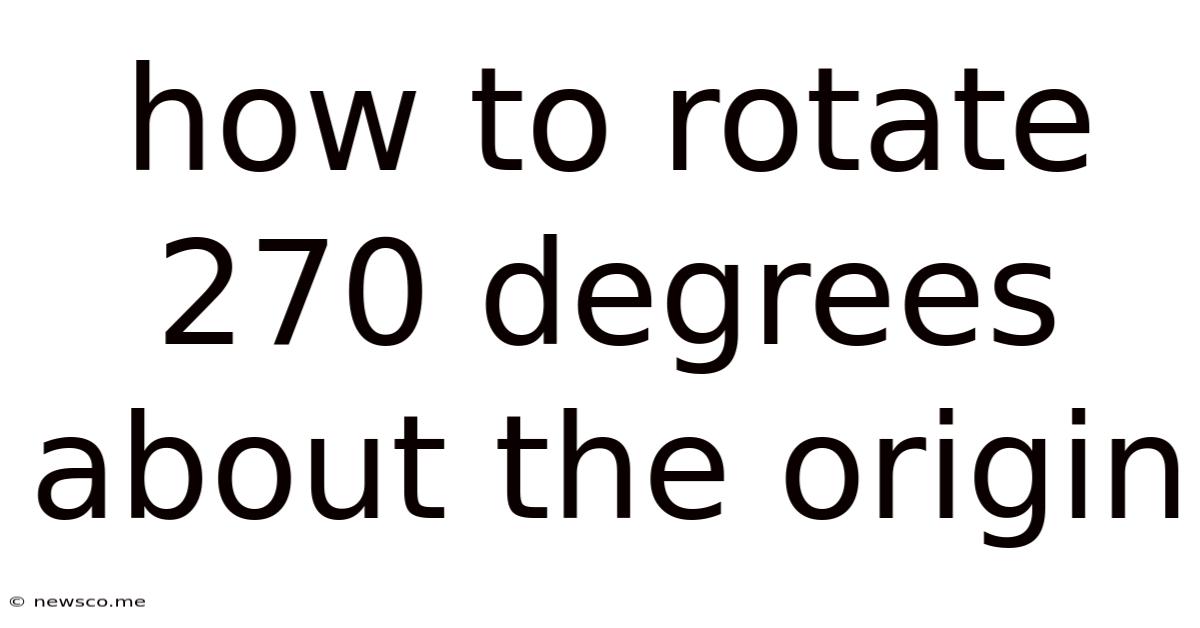How To Rotate 270 Degrees About The Origin
News Co
Apr 23, 2025 · 4 min read

Table of Contents
How to Rotate 270 Degrees About the Origin: A Comprehensive Guide
Rotating a point 270 degrees about the origin is a fundamental concept in geometry and linear algebra, with applications spanning various fields like computer graphics, game development, and physics simulations. This comprehensive guide will delve into the intricacies of this transformation, explaining the underlying principles, providing step-by-step instructions, and exploring different approaches to achieve this rotation.
Understanding Rotation About the Origin
Before we dive into the specifics of a 270-degree rotation, let's establish a solid foundation. Rotation about the origin refers to transforming a point's coordinates in a Cartesian plane by revolving it around the origin (0, 0) by a specified angle. This transformation preserves the distance of the point from the origin; it simply changes its orientation.
A 270-degree counterclockwise rotation is equivalent to a 90-degree clockwise rotation. Understanding this equivalence is crucial as many resources primarily focus on counterclockwise rotations.
Method 1: Using Rotation Matrices
The most efficient and mathematically rigorous method for rotating a point is using rotation matrices. A rotation matrix is a 2x2 matrix that, when multiplied with the coordinate vector of a point, yields the new coordinates after rotation.
For a 270-degree counterclockwise rotation (or 90-degree clockwise rotation), the rotation matrix is:
R(270°) = [[0, 1],
[-1, 0]]
To rotate a point (x, y) 270 degrees counterclockwise about the origin, we perform the following matrix multiplication:
[[x'], [y']] = [[0, 1], [-1, 0]] * [[x], [y]]
This results in the following equations:
- x' = y
- y' = -x
Therefore, to rotate a point (x, y) 270 degrees counterclockwise about the origin, simply swap the x and y coordinates and negate the new x-coordinate.
Example:
Let's rotate the point (3, 4) 270 degrees counterclockwise about the origin:
- x' = y = 4
- y' = -x = -3
The rotated point is (4, -3).
Method 2: Geometric Approach (for visualization)
While rotation matrices provide the most concise solution, a geometric approach can enhance understanding. Imagine the point (x, y) as a vector originating from the origin. A 270-degree counterclockwise rotation will effectively "flip" and reposition this vector.
- Visualize: Draw the point (x, y) on a Cartesian plane.
- Reflect and Rotate: Imagine reflecting the point across the line y = x. This swaps the x and y coordinates, resulting in (y, x).
- Reflect again: Now, reflect this new point across the x-axis. This negates the y-coordinate, resulting in (y, -x).
This geometric approach visually demonstrates the transformation, leading to the same result as the matrix method: (y, -x).
Method 3: Using Complex Numbers (Advanced Approach)
Complex numbers offer an elegant and powerful way to represent rotations. A point (x, y) can be represented by the complex number z = x + iy, where 'i' is the imaginary unit. A rotation by an angle θ counterclockwise can be achieved by multiplying z by e^(iθ), where e is Euler's number.
For a 270-degree counterclockwise rotation (θ = 270° = (3π/2) radians), the rotation is represented by:
e^(i(3π/2)) = cos(3π/2) + i sin(3π/2) = 0 - i = -i
Therefore, to rotate z = x + iy by 270 degrees counterclockwise, we multiply it by -i:
z' = -i(x + iy) = -ix - i²y = y - ix
This results in the new complex number z' = y - ix, which corresponds to the point (y, -x), consistent with our previous methods.
Practical Applications
The ability to rotate points 270 degrees about the origin is fundamental in several applications:
- Computer Graphics: Rotating images, objects, and characters in video games and 3D modeling software relies on these transformations.
- Robotics: Calculating the position and orientation of robotic arms involves rotations around various axes, including the origin.
- Image Processing: Image manipulation and analysis often requires rotating images or image features.
- Physics Simulations: Modeling projectile motion, planetary orbits, and other physical phenomena frequently involves rotating coordinate systems.
- Signal Processing: Rotating vectors in signal spaces is used in applications like image filtering and antenna array processing.
Handling Multiple Rotations
Rotating a point multiple times involves applying the rotation matrix successively. For example, a 270-degree rotation followed by a 90-degree rotation is equivalent to a 360-degree rotation (or no rotation at all).
Rotation in 3D Space
While this guide focuses on 2D rotations, the principles extend to 3D space. In 3D, rotations are represented by 3x3 rotation matrices and involve rotations around the x, y, and z axes.
Conclusion
Rotating a point 270 degrees about the origin is a core geometric operation with broad applications. Whether you use rotation matrices, a geometric approach, or complex numbers, understanding the underlying principles ensures you can effectively perform this transformation in various contexts. Mastering this concept strengthens your foundation in mathematics and opens doors to numerous advanced applications in computer science, engineering, and beyond. Remember to practice using different points and visualize the transformations to solidify your understanding. The more you practice, the more intuitive this process will become. Through consistent practice and application, you'll be able to confidently handle these rotations in any scenario. Remember to always double-check your calculations to ensure accuracy.
Latest Posts
Related Post
Thank you for visiting our website which covers about How To Rotate 270 Degrees About The Origin . We hope the information provided has been useful to you. Feel free to contact us if you have any questions or need further assistance. See you next time and don't miss to bookmark.